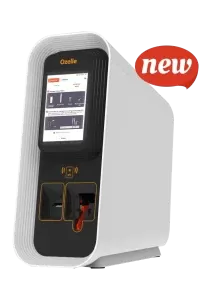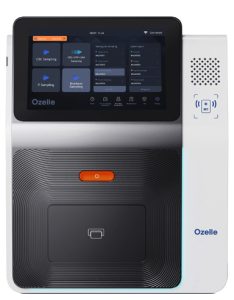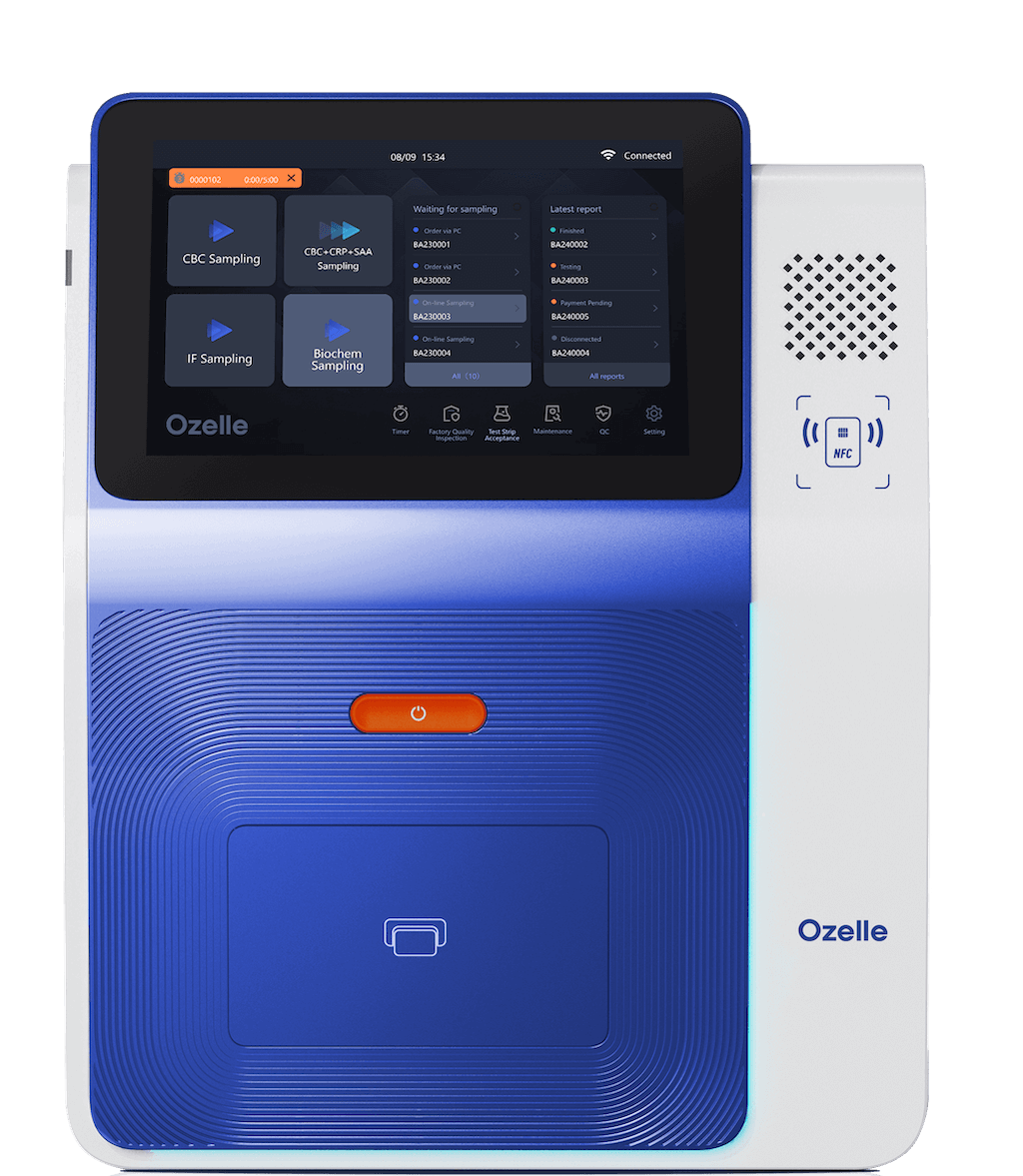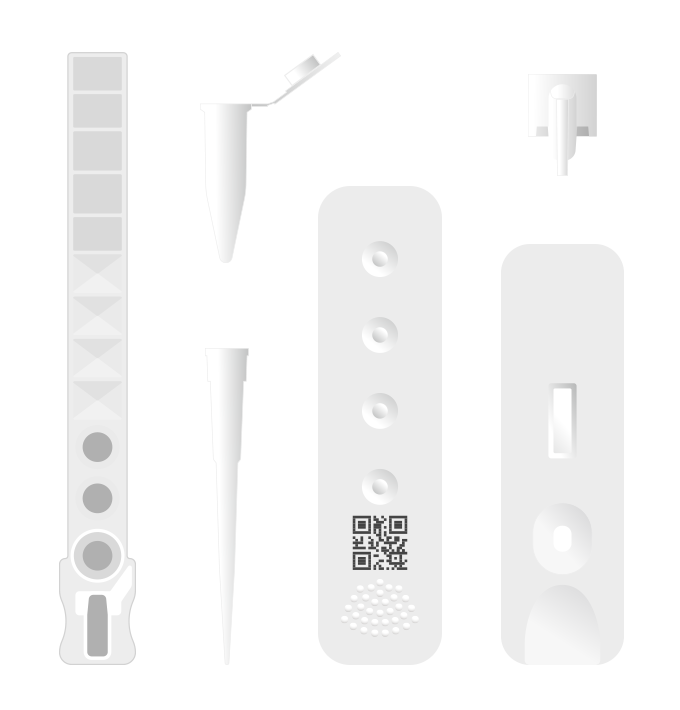Point-of-care testing (POCT) has emerged as one of the most transformative trends in primary healthcare delivery. In community health centers, private clinics, pharmacies, urgent care facilities, and general practitioner offices, immediate diagnostic capability means faster patient outcomes, better treatment decisions, and enhanced care quality. At the heart of this revolution is the compact hematology analyzer—specifically designed for the realities of primary care environments where space, complexity, and maintenance resources are limited.
The Ozelle EHBT-25 represents the next generation of point-of-care complete blood count technology. As a compact, AI-powered cell morphology analyzer engineered for community-based settings, it delivers laboratory-grade hematological diagnostics with unprecedented simplicity and reliability. This article explores how Compact Hematology Analyzers are reshaping point-of-care diagnostics and why the EHBT-25 exemplifies the future of accessible healthcare diagnostics.
The Point-of-Care Testing Revolution
Why Primary Care Needs On-Site Diagnostics
Primary healthcare settings operate under fundamentally different constraints than centralized laboratory environments. A community health center in an underserved urban neighborhood, a rural clinic, or a private practitioner’s office cannot maintain the infrastructure of a hospital laboratory. Yet the patients in these settings need rapid diagnostic answers just as urgently as any hospitalized patient.
Consider a few typical primary care scenarios:
Patient with Suspected Anemia: A patient presents with fatigue and shortness of breath. With EHBT-25, the provider receives anemia classification within 10 minutes—identifying microcytic, normocytic, or macrocytic patterns through RBC indices. This morphological classification guides immediate decisions: iron supplementation for suspected iron deficiency, transfusion protocols for acute loss, or specialist referral for complex cases. While EHBT-25 provides diagnostic direction, confirming etiology (iron deficiency vs. B12 deficiency vs. hemolysis) typically requires additional clinical correlation or specialized testing. Immediate point-of-care assessment replaces days of diagnostic delay.
Suspected Infection: A patient with fever and systemic symptoms needs rapid assessment of white blood cell count and differential to guide whether bacterial infection is likely and whether antibiotics should be initiated empirically. A white count of 3,000 (leukopenia) suggests viral etiology; a count of 15,000 with left shift strongly suggests bacterial infection. This distinction determines immediate treatment—and time matters profoundly in sepsis and serious infections.
Medication Monitoring: Patients on chemotherapy, immunosuppressants, or certain antibiotics require regular CBC monitoring. Having this capability in the primary care office means patients can have same-day results without multiple laboratory visits, improving adherence and safety monitoring.
Chronic Disease Management: Diabetic patients, those with chronic kidney disease, and patients on multiple medications benefit from regular hematological assessment. On-site testing transforms routine monitoring from a cumbersome multi-visit process into seamless integration with office visits.
In each scenario, the ability to obtain CBC results within the same clinical encounter—rather than 24-48 hours later—fundamentally changes clinical outcomes.
The Ozelle EHBT-25: Engineered for Point-of-Care Simplicity
Four-Step Operation: Simplicity as Strategy
The Ozelle EHBT-25 was designed from the ground up with point-of-care reality in mind. Rather than the complex, maintenance-intensive workflows of traditional hematology analyzers, the EHBT-25 accomplishes complete blood count analysis in four steps:
Step 1: Fingerstick Blood Collection. The healthcare provider or patient collects capillary blood via a simple fingerstick—requiring only 40µL of blood. This minimal sample volume means:
- Reduced patient discomfort compared to venipuncture
- Elimination of special collection tubes or anticoagulant requirements
- No need for phlebotomy expertise
- Particularly valuable for pediatric patients where minimizing blood draw volumes prevents iatrogenic anemia
- Option for patient self-collection in selected appropriate scenarios
Step 2: Load Individual Test Kit. The blood is loaded into the EHBT-25’s individual test cartridge. This single-use cartridge contains all necessary reagents, dilution chambers, and counting chambers pre-configured for analysis. No liquid pipetting, no reagent preparation, no complex sample handling.
Step 3: Press and Fit Cartridge into Analyzer. The healthcare provider simply inserts the loaded cartridge into the analyzer—a straightforward mechanical process requiring no technical expertise.
Step 4: Results Displayed Instantly. Within minutes, the EHBT-25 delivers complete 3-differential CBC results with 21 parameters and three histograms directly to the 10.1-inch touch screen display.
This simplicity is deceptive in its power. By eliminating complexity, the EHBT-25 eliminates the barriers that prevent primary care settings from offering on-site hematology testing.
Cell Morphology + AI: Beyond Traditional Analysis Methods
The EHBT-25 employs cell morphology analysis enhanced by artificial intelligence—a fundamentally different approach than traditional hematology analyzers relying on impedance counting or flow cytometry.
How Cell Morphology Analysis Works:
The analyzer captures high-resolution digital images of individual blood cells as they pass through the counting chamber. Rather than measuring electrical impedance (which provides only cell size) or fluorescent light scatter (which requires expensive flow cytometry), cell morphology imaging directly visualizes cell size, shape, internal structure, and color characteristics.
The AI Advantage:
Ozelle‘s proprietary AI algorithm was recognized at the 2022 World Artificial Intelligence Conference as one of the best algorithms applied to diagnostic technology. This algorithm has been trained on 40 million blood cell images, enabling pattern recognition and classification capabilities that rival expert hematologists.
The AI-powered morphology analysis enables the EHBT-25 to:
- Accurately differentiate white blood cell types (neutrophils, lymphocytes, monocytes, eosinophils, basophils)
- Detect immature granulocytes (bands, metamyelocytes) and immature lymphoid forms suggesting acute leukemia
- Identify abnormal cell morphologies including schistocytes (fragmented RBCs), spherocytes, or other formed element abnormalities
- Provide visual cell images alongside numerical results—enabling the provider to see what the analyzer is actually counting
This visual capability is particularly valuable in primary care. Rather than abstract numbers, the clinician can review actual cell images to verify the analyzer’s interpretation.
Maintenance-Free Operation: Reliability When Expertise Isn’t Available
Traditional hematology analyzers require regular preventive maintenance. Daily cleaning of pipette tips and staining chambers, weekly flushing of liquid systems, periodic reagent calibrations—these routine maintenance tasks are complex, time-consuming, and require specialized technical expertise. When maintenance is missed or performed incorrectly, analyzer reliability and result accuracy suffer.
The EHBT-25 eliminates this entire burden through a maintenance-free architecture:
No Liquid Pipelines: Unlike traditional analyzers with complex internal piping systems, tubing, and reagent reservoirs, the EHBT-25 uses individual test cartridges. Each cartridge is used once and then discarded. There are no pipes to clog, no staining chambers to clean, no calibration liquid to prepare.
Dry-Type Quality Control: Rather than liquid QC materials requiring temperature control and stability verification, the EHBT-25 uses dry-type QC cards. Quality verification becomes a simple cartridge-based process—run a dry QC card through the same loading process as patient samples, and receive QC results instantly.
Room Temperature Storage: Test cartridges are stored at room temperature without refrigeration or special environmental controls. This eliminates cold chain complications and makes inventory management straightforward.
Plug-and-Play Reliability: The EHBT-25 is designed to be loaded with a patient sample and provide a result. No technician expertise required. No maintenance schedule needed. Just consistent, reliable operation shift after shift.
This maintenance-free design is particularly crucial for primary care settings. A small community clinic or private practice office cannot support a dedicated biomedical technician to manage complex laboratory equipment. Maintenance-free operation means:
- Less staff training required
- Reduced downtime and service calls
- Consistent performance without requiring specialized expertise
- Equipment that supports, rather than burdens, primary care operations
Individual Test Kits: Safety, Simplicity, and Cost Control
Each EHBT-25 test utilizes an individual, single-use test cartridge. This approach differs fundamentally from traditional analyzers that draw sample from collection tubes and process using permanent internal reagent systems.
Patient Safety: Individual test kits eliminate cross-contamination risks. Each patient’s sample is processed in a fresh, unused cartridge. There’s no possibility of carryover from previous samples—a critical safety consideration in infection control.
Operational Simplicity: No reagent preparation, no system flushing between samples, no contamination risk management—just load, analyze, dispose. This simplicity transforms hematology testing from a complex technical procedure into a straightforward clinical workflow.
Cost Control and Economies: The variable cost per test is known precisely—the cost of the individual test cartridge. Facilities can budget accurately without complex reagent purchasing, waste management, or maintenance cost variability. This predictability is particularly valuable for small facilities with limited financial management flexibility.
Cold-Chain Free: Unlike many laboratory reagents, EHBT-25 test cartridges require no refrigeration or special storage conditions. Room temperature storage simplifies supply chain management, reduces waste from temperature excursions, and eliminates refrigeration equipment requirements.
Point-of-Care Applications for the EHBT-25
Community Health Centers and Primary Care Clinics
Community health centers serving underinsured and uninsured populations often struggle with diagnostic access. Patients may lack reliable transportation for laboratory visits, may experience barriers scheduling multiple appointments, or may simply not return for test result follow-up. By deploying the EHBT-25 on-site, community health centers transform the diagnostic experience:
A patient arrives with symptoms suggestive of anemia. Traditional workflow: provider orders test, patient makes separate trip to laboratory, waits for results, schedules return visit to discuss findings and plan treatment.
EHBT-25 workflow: provider collects fingerstick sample during the office visit, Compact Hematology Analyzer provides results within 15 minutes, provider discusses findings and initiates treatment—all in a single encounter. The patient leaves with clear understanding of their condition and treatment plan.
This same-visit diagnostic and treatment capability dramatically improves outcomes. Patients with identified anemia can begin iron supplementation immediately. Patients with elevated white counts suggesting infection can receive prescriptions on the same day. The friction and delay that characterizes traditional laboratory workflows are eliminated.
Private Medical Practices and Solo Practitioners
Solo practitioners and small group practices have particularly constrained laboratory resources. Outside hospital systems, these providers often lack integrated laboratory access and must send specimens to reference labs with 24-48 hour turnaround times.
The EHBT-25 enables private practices to offer point-of-care CBC testing competitive with large institutional healthcare systems. A private rheumatology practice monitoring patients on disease-modifying antirheumatic drugs (DMARDs) can obtain CBC results during follow-up visits to track white count trends and adjust therapy. A cardiologist managing patients on antiplatelet therapy can verify platelet counts as part of safety monitoring. A family medicine practice can provide immediate assessment of acute infections.
This capability enhances practice value, improves patient satisfaction through faster results, and enables more responsive clinical decision-making.
Pharmacy-Based Testing Programs
Pharmacists increasingly provide direct patient care services including medication management, chronic disease monitoring, and preventive health screening. The EHBT-25, designed for NPT (Non-Physician) operation, is specifically suited for pharmacy-based testing programs.
A pharmacist managing a patient on chemotherapy can verify CBC status during pharmacy visits without requiring physician office involvement. A pharmacist running a diabetes management clinic can monitor CBC as part of routine care. A pharmacist providing occupational health screening for workplace employees can offer immediate CBC assessment as part of comprehensive health evaluation.
These expanded pharmacy roles improve healthcare access while supporting pharmacists’ professional evolution into expanded clinical roles.
Urgent Care and Occupational Health Centers
Occupational health services, urgent care centers, and workplace clinics serve patients who need rapid diagnostic answers in non-traditional clinical settings. The EHBT-25’s portability (8.1kg weight, compact dimensions), maintenance-free operation, and minimal infrastructure requirements make it ideal for these settings.
An occupational health clinic can perform pre-employment CBC screening on-site. An urgent care facility can rapidly assess infection status in acutely ill patients. A workplace health promotion program can offer health screening including hematology assessment as part of employee wellness initiatives. All without complex laboratory infrastructure or delayed result turnaround.
Mobile Health and Remote Clinic Applications
Healthcare delivery is increasingly mobile and distributed. Mobile clinics serving homeless populations, temporary health screening events, or remote international health programs need diagnostics that are truly portable and infrastructure-independent.
The EHBT-25 weighing only 8.1kg with 100-240V universal power supply can operate in environments far removed from traditional laboratories:
- Mobile health clinics on trucks or buses
- Emergency medical response vehicles
- International medical missions to resource-limited regions
- Temporary field clinics during disaster response
- Temporary health screening sites at remote work locations
The ability to transport a fully functional CBC analyzer to patients—rather than transporting patients to analyzers—opens new possibilities for healthcare delivery in underserved regions.
Clinical Performance and Lab-Grade Accuracy
Validation Data Confirming Accuracy
The EHBT-25 isn’t a simplified home-use device; it delivers laboratory-grade hematology results meeting clinical standards. Published validation data demonstrates:
High Correlation with Reference Methods:
- WBC correlation: r² = 0.9793 (y=1.29 + 0.95x)
- RBC correlation: r² = 0.9821 (y=-1.064 + 0.983x)
- Hemoglobin correlation: r² = 0.9858 (y=0.217 + 1.01x)
- Platelets correlation: r² = 0.9507 (y=-0.262 + 0.992x)
These r² values above 0.95 indicate exceptional agreement with reference laboratory methods. Results from the EHBT-25 are not approximations or screening values—they are diagnostically reliable complete blood counts suitable for clinical decision-making.
21 Parameters Delivered:
The EHBT-25 doesn’t provide only basic CBC—it delivers comprehensive hematology assessment including:
- WBC and 3-differential (neutrophils, lymphocytes, monocytes)
- Absolute and relative counts for each differential population
- Complete red blood cell indices (MCV, MCH, MCHC, RDW-SD, RDW-CV)
- Hemoglobin and hematocrit
- Complete platelet parameters (PLT, PCT, MPV, P-LCC, P-LCR, PDW)
- Three diagnostic histograms (WBC, RBC, and PLT distributions)
This comprehensive parameter set matches full-featured reference laboratory analyzers—there are no shortcuts or limitations in the clinical information provided.
Visual Cell Images:
Unlike traditional analyzers that provide only numerical results, the EHBT-25 captures and displays actual cell images. This visual representation enables:
- Verification of morphologically abnormal findings
- Clinician confidence in automated result interpretation
- Educational value for staff understanding actual cell appearance
- Documentation of morphological findings in the patient record
- Ability to identify potential reflex testing needs (e.g., suspected leukemia, unusual morphology)
Comparison with Traditional Hematology Methods
EHBT-25 Compact Hematology Analyzer vs. Traditional Impedance-Based Analyzers
| Characteristic | EHBT-25 (Cell Morphology + AI) | Traditional Impedance Methods |
| Principle | Cell morphology imaging with AI analysis | Electrical impedance measurement |
| Reagent System | Individual test cartridges, room temperature storage | Complex liquid pipeline with multiple reagent reservoirs |
| Maintenance | Maintenance-free operation | Frequent maintenance (daily/weekly flushing, calibration, reagent preparation) |
| Sample Volume | 40µL fingerstick capillary blood | Typically requires venipuncture, larger volumes |
| Cross-Contamination Risk | Eliminated through single-use cartridges | Potential carryover from previous samples |
| Infrastructure | Minimal—standard electrical outlet, room temperature storage | Requires deionized water system, biological waste management, complex utilities |
| Operator Expertise | Minimal training—four-step workflow | Requires laboratory technician training and ongoing expertise |
| Result Information | 21 parameters + visual cell images + histograms | CBC parameters only, no morphological assessment |
| Ideal Settings | Primary care, clinics, urgent care, pharmacies, mobile health | Centralized laboratories, hospital settings |
| Cost Model | Predictable variable cost (cartridge cost) | Complex cost structure (reagent, maintenance, waste management) |
This comparison clearly illustrates why the EHBT-25 represents a fundamentally different approach to hematology testing—optimized for point-of-care primary healthcare delivery rather than centralized laboratory environments.
Implementation in Primary Care Settings
Workflow Integration
Morning Setup: A staff member runs a dry-type QC card through the EHBT-25 during morning startup—a 5-minute verification process ensuring analyzer readiness. Results are documented and the device is ready for patient testing.
Patient Testing During Visits: As patients arrive for appointments and providers identify need for CBC testing, a fingerstick sample is collected and loaded into a test cartridge. Within 15 minutes, results appear on the display screen.
Results Documentation: Results are automatically transmitted via USB or LAN to the practice management system or EHR if connectivity is configured, or manually entered if paper-based systems are used.
Same-Visit Clinical Decision-Making: Providers review results with patients, discuss findings, and initiate treatment plans immediately—all within a single clinical encounter.
Staff Training Requirements
Unlike complex laboratory analyzers requiring extensive operator certification, the EHBT-25 requires minimal training:
Initial Training: 2-4 hours of hands-on operation covering:
- Proper fingerstick collection technique
- Cartridge loading procedure
- Result interpretation and normal ranges
- QC verification and documentation
- Basic troubleshooting (most issues solved by contacting vendor support)
Ongoing Training:
- Quarterly refresher training reviewing technique and common errors
- Annual competency assessment ensuring consistent performance
- Staff rotation to ensure backup operators available
Most primary care staff can achieve proficiency with minimal disruption to clinical operations.
Quality Assurance and Regulatory Compliance
The EHBT-25 is designed to support regulatory compliance in primary care settings:
Quality Control Documentation: Dry-type QC results are automatically recorded and timestamped, creating compliant documentation of analyzer performance verification.
External Proficiency Testing: Participation in CAP (College of American Pathologists) or other external proficiency testing programs enables periodic validation of accuracy against reference methods.
Calibration Compliance: The EHBT-25 supports both automatic and manual calibration modes, enabling flexibility in compliance approaches.
Result Validation: The combination of numerical results and visual cell images enables clinician validation of whether results are consistent with clinical presentation.
Conclusion: The Future of Primary Care Diagnostics Is Here
The Ozelle EHBT-25 exemplifies the future of point-of-care diagnostics. By combining laboratory-grade accuracy, AI-powered cell morphology analysis, maintenance-free operation, and minimal infrastructure requirements, the EHBT-25 brings comprehensive hematology testing to primary care settings previously unable to offer this capability.
The barriers that historically separated point-of-care testing from laboratory-grade diagnostics have been eliminated. The EHBT-25 doesn’t represent simplified testing or screening alternatives—it provides the same 21-parameter, three-differential complete blood count that centralized laboratories deliver, but with rapid turnaround and seamless primary care integration.
For community health centers serving underserved populations, primary care practices seeking modern diagnostic capability, pharmacies expanding clinical services, urgent care facilities, occupational health programs, and mobile health initiatives, the EHBT-25 offers transformative potential. Same-visit diagnostic and treatment capability improves patient outcomes, enhances patient experience, and modernizes primary care practice.
The future of healthcare diagnostics is decentralized, immediate, and patient-centered. The Ozelle EHBT-25 Compact Hematology Analyzer is making that future available today.





